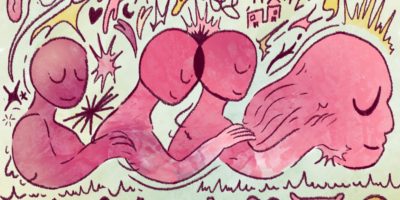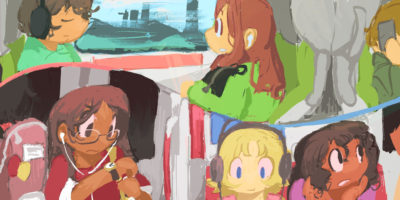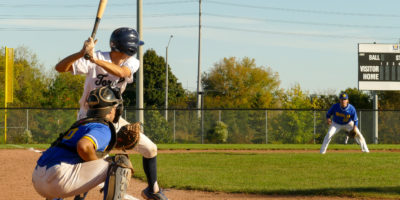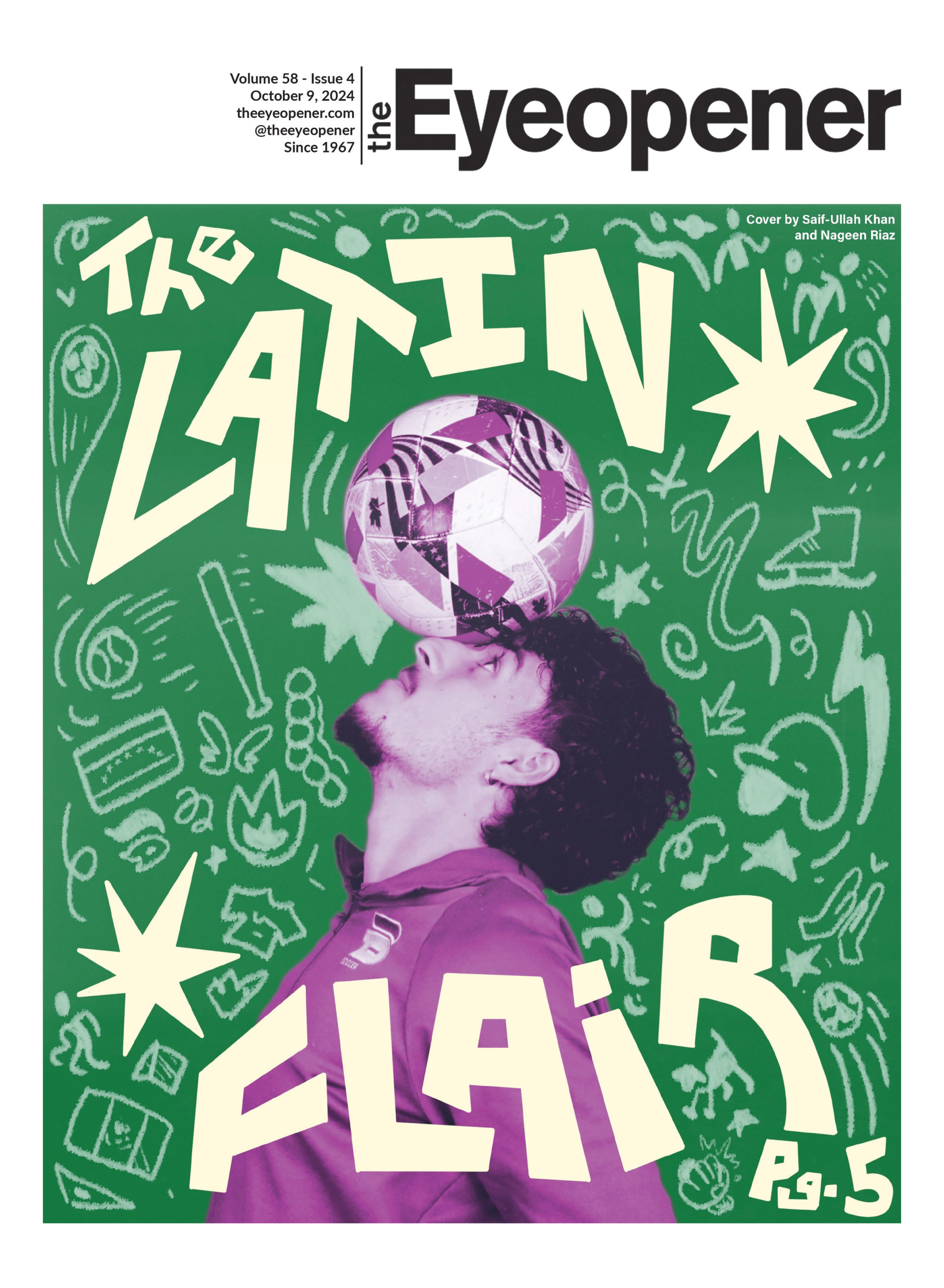By David White
The Simpsons is a damn funny show. All agreed? Then let’s move on. We all know the Simpsons is the funniest thing on television but what makes it so successful? How does a cartoon move from being filler on the Tracy Ullman Cosby Show? The answer my friends, if I may be so assuming, is volume, and that it works on so many darn levels.
Bart one case, of an “Itchy and Scratchy” cartoon, “It’s funny on so many levels.” But “Itchy and Scratchy” works on one level: violence. Their theme song has about three words, two of which are “fight” and “bite”. Bart’s ironic comment causes us to think about the many levels the Simpsons does work on, spanning from lowbrow monster-truck-rally humour to literary allusion and piercing parody. The Simpsons is definitely a cartoon written by adults for adults yet it still appeals widely to children (judging by the merchandise sales.) The drawings and voices are appealing to children, they can laugh at the snout-like nose of Chief Wiggums without ever having heard the police referred to as ‘pigs’ (except perhaps by Snake, Springfield’s resident con.) Children can also laugh at the funny accent of Mayor Quimby without needing to know that he is a parody of President Kennedy. There are also numerous drawings of buttcracks to keep kids amused. Certainly this humour is not only attractive to children; anybody who has read one of the Simpsons comic books knows immediately how much the voices and timing add to the show.
There would be no funny voices to listen to, no Homer saying ‘D’oh!’ or Marge “mmmmning’ if it were not for the writers, who I am positive are from another, far funnier, planet than this one. All of the Simpsons writers are graduates from the Harvard Lampoon. The two shows with the greatest writing currently on t.v. are (incidentally this is merely my opinion, which just happens to be correct) Seinfeld and the Simpsons. They both work in very different ways. Seinfeld is the William Wordsworth of television, making the normal abnormal. Wordsworth would make us see something mystical in the eyes of a simple child or shepherd; Seinfeld makes arguing over a parking spot seem like the most important thing on Earth. Conversely, the Simpsons are comparable to the writer Samuel Taylor Coleridge; making the strange normal. A drinking, smoking, gamblign clown named Krusty is a popular children’s television show host. He’s had stiff competition though: a marionette named Gabbo nearly ruined Krusty’s career. Springfield is populated by odd characters who are completely at home with each other (but that’s a different story entirely, one that must wait till near the end of the article).
Another reason people are still tuning into this cartoon after seven seasons is for its accurate movie parodies. Mel Brooks made a fortune through movie parodies, then he made “Space Balls” but that too is an entirely different story and one that involves a lot of retching. The Simpsons do not merely parody movies, in fact they rarely devote a whole episode to the task. When Lisa did her science experiment “Is my brother stupider than a hamster?” I think few people saw the connection between her second grader science project and the disturbing early 70’s movie “A Clockwork Orange.” Yet Bart reaching for cupcakes with cherries on top looks very much like Alex grasping for a pert young women’s breasts. Both Alex and Bart have been shocked into believing that the respective objects of their affection are bad for them and end up in fetal position on the floor. When the opening scene of “Raiders of the Lost Ark” was parodied by Bart stealing Homer’s coin jar, no detail was overlooked. Homer’s coin jar was the exact size of the idol Indiana Jones sought and his rotund shape made him perfect for the role of the boulder. Bart was chased through the house by a rolling Homer and was nearly caught by the closing garage door even reaching back to get his lucky red hat. The parodies have comedic value on their own, but being able to compare the Simpsons scene to the real film adds an even greater level of humour. Sometimes a viewer may not have seen the movie being parodied but only gets a sense that some teasing is going on. This is also true of many of the literary references on the Simpsons. Matt Groening has said that there are many jokes on the show that people will not fully appreciate unless they have taken Literature 101. Lisa’s thanksgiving poem for example is highly influenced by Allan Ginsberg’s “Howl.” Unlike most inside jokes however you do not need to know the reference to see the humour. Lisa reciting lines about the greatest turkeys of her generation being eaten is still comedic on its own. And nobody needs to have read A Streetcar Named Desire to laugh at Ned Flanders sing/scream: “Stella, Stella/Can’t you hear me yella/You’re putin’ me through hell/Stella.”
The writers of the Simpsons have done for Ned Flanders what they have done for every character on the show, given them depth and personality. The town of Springfield is like James Joyce’s Dublin. I am certain my old James Joyce prof would give me a severe beating for even attempting a comparison between Joyce and the Simpsons but I will carry on heedlessly because that’s the kind of reckless rough and tumble guy I am. The characters in Ulysses are fictional characters who Joyce made realistic. People can now tour Dublin on the same course that Leopold Bloom took on his day’s journey in Ulysses. They buy the citron soap that he bought for Molly and can see the same sights that he did. Perhaps in the future we will all walk through Springfield, stop at Moe’s for a flaming Homer, go see Apu at the Kwik-E-Mart, and maybe get a lemon from the lemon tree that those inbreeders from Shelbyville tried to steal. And then again maybe I’m just writing this thing way too late. Joyce carried some characters over from book to book. We meet Bob Doran in the Dubliners and again in Ulysses and Stephen Dedalus of course is a big carry over from Portrait of the Artist as a Young Man to Ulysses. Using the same characters in different texts made Joyce’s characters more realistic, people that have read Portrait feel like they already know Stephen when they read Ulysses just as the characters in the Simpsons become more familiar and thus realistic when we see them over and over again. In case anyone is wondering, I do not really expect to run into Mr. Burns and Waylon Smithers, or any other character, any time soon, (although it would be a dream come true) I just think that we can get to know how they tick. I could never feel that with Fred, Barney or Scooby-doo. Speaking of Fred and Barney I hope people do not think it is a coincidence that both Fred and Homer have a best friend named Barney. One is a short, cute, wisecracker and the other is a drunken, belching slob who talks to giant beer cans and makes art films. The Simpsons writers allow no opportunity to pass them by. They knew that they would be compared to The Flintstones and the difference between the Barneys I believe is meant as an example of how different the shows really are. Everybody on the Simpsons has a distinct parodic personality. Troy McClure is a smooth talking has-been actor who now appears in everything from infomercials, to driver safety films, to soft-core pornos (The Erotic Adventures of Hercules wit hNorman Fell as Zeus, isn’t that a pretty picture.) Miss. Krabappel is Bart’s lonely fourth grade teacher who has tried to seduce many an unlikely suitor, she even had a thing for the mucho suave, mucho old, hockey legend Gordie Howe. We know Lionel Hutz as the shifty lawyer who defends the Simpsons whenever they go to court, which happens fairly often for a middle class family. He also gives out smoking monkeys and lives at the Y. It would be fun for me but pointless for you if I listed all of the characters names and roles so I hope it is suffice to say that each character radiates his or her own brand of humour. Just thinking of episodes that have been centred on personalities outside of the Simpson family is enough I think to show the significance of these characters. Even Sideshow Bob, whose purpose in life is to be a second banana, has had a few episodes based around him.
We finally come to the family Simpson, the crème de la crème of television families. The writers clearly intended us to form a bond with these people. Homer, Marge, Lisa and Maggie are all named after Matt Groening’s real life family (Bart was used because it is an anagram of Brat). Groening personalizes the Simpsons by naming them after his own family and universalizes them by giving Marge the maiden name of the most beloved First Lady in recent history Jacqueline Bouvier Kennedy, but you can bet your sweet ass that Homer Simpson is no Jack Kennedy. If we feel that we know the other characters on the show we must be related to Homer and the Gang, or at least really close friends. The Simpsons are the voices of their creators. Lisa is a moral voice, she says that she is no theologian, she only knows that God is a force more powerful than Homer and Marge combined, yet she knows enough that if you pray for a miracle (à la Bart) adn you get it, you “owe God big.” Lisa refuses to watch stolen cable even if horsies are on it. Why not? Because Hell is a scary place. She obeys the law of God more because she fears the consequences than because she is a truly good person. Marge, on the other hand, obeys God because she is a good person and believes the bible (except when Homer quotes it and throws in words like ‘moocher.’) Marge does not have the quick intelligence that Lisa does but she knows right from wrong. Bart is a soap box for the writers. He tells us indirectly, that the Simpsons works on different levels. And he did say, when watching an episode of “Dinosaurs,” “It’s like they saw our life and put it on t.v.” A less than subtle shot at rip-off artists. Bart even got to rebut President Bush when he said the nation should be more like the Walton and less like the Simpsons. Bart replied they were like the Waltons, both waiting for the depression to end. Homer is our voice. He is allowed to say that being popular is the most important thing in life, he is allowed to laugh at professors who drop their cards and he is allowed to eat sixty four slices of processed cheese in one night. Homer lives for the pleasure principle and rarely ventures towards reality. I think we would all like to be Homer to some degree but the Lisa in us is always afraid of the consequences.
This Freudian connection to television’s favourite family makes the three-fingered yellow bastards almost addictive. Everyone between six and 60 is hooked on the half-hour fix that is the Simpsons.









Leave a Reply